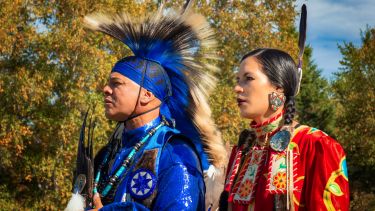By Beth Porter
Follow Beth on Twitter or connect with them on LinkedIn.
In October 2021, the landmark First Nations Food, Nutrition and Environment Study (FNFNES) was published. Its findings are sobering; half of First Nation households struggle to get enough food, compared to 12% of the Canadian population. Obesity levels are twice the national rate and cultural food practices are in decline. The report also drew a link between chronic food insecurity and environmental degradation.
How did we get here? What can guarantee sufficient, healthy, and culturally-appropriate foods for First Nation communities?
Oxfam believes the Sustainable Livelihoods Approach (SLA) is key. Using a complex framework to map multiple dimensions of poverty, the SLA works with communities to harness their abilities and resources and lift themselves out of poverty.
On paper, the SLA’s goals fit neatly with the First Nations’ fight for food. A key SLA outcome is food security, and its focus on sustainable livelihoods that persist “now and in the future, while not undermining the natural resource base” (DFID, 2001, 1.1.) mirrors the Mi’kmaq belief that food security for all generations is only possible through ‘netukulimk’ - an indigenous worldview that treats Earth’s bounty and limits as sacred.
But can the SLA understand First Nations’ food insecurity and advance netukulimk in practice? Its participatory nature certainly illuminates unique indigenous perspectives, like the primary importance of hunting and sharing country foods for food security (Thompson et al., 2012, p.43) - a view that shuns typical Western solutions.
But despite this, indigenous food insecurity is getting worse. The SLA is missing a key puzzle piece. Focused on bottom-up perceptions of poverty, it misses vital power structures that make and perpetuate inequalities from the top-down.
This is problematic for aboriginal livelihoods that are disproportionately constrained by colonialism through continued state control of indigenous lands and erosion of traditional foodways. The capitalist food system blocks community access to nutrition through exorbitantly-priced fresh produce (valued to absorb large transportation costs and protect profits), forcing reliance on cheap, highly-processed diets that are feeding the diabetes epidemic unfolding in First Nations. These systems have environmental impacts, too; state mines on aboriginal lands cause widespread pollution which, entwined with the impact of the corporate food regime on climate change, is destroying the landscapes First Nations view as essential to netukulimk.
Without recognising or challenging these structures, the SLA can only promote local-level resilience to the colonial, capitalist, and ensuing environmental causes of indigenous poverty and food insecurity, holding Mik’maq and First Nation peoples in their vulnerability. This ‘D.I.Y development’, materialising as business plans and improved social safety nets (Thompson et al., 2014, p.189), may offer temporary respite but is nothing more than a painkiller. These livelihoods are neither food secure, nor sustainable, nor in pursuit of netukulimk.
The FNFNES concluded by recommending measures to advance First Nation food security. Among them were indigenous self-determination, a return to traditional foods, and environmental protection. For these to be achieved, the SLA is not enough. Community-level action must be paired with radical approaches that challenge the colonial and capitalist barriers to netukulimk. Without it, food security will remain firmly out of reach.
References:
- DFID (2001) Sustainable Livelihoods Guidance Sheets. London: DFID.
- Thompson, S. et al. (2012) ‘Community Development to Feed the Family in Northern Manitoba Communities: Evaluating Food Activities Based on Their Food Sovereignty, Food Security and Sustainable Livelihood Outcomes’, Canadian Journal of Nonprofit and Social Economy Research, 3(2), pp. 43-66.
- Thompson, S. et al. (2014) ‘Pulling in the indigenous fishery cooperative net: Fishing for sustainable livelihoods and food security in Garden Hill First Nation, Manitoba, Canada’, Journal of Agriculture, Food Systems, and Community Development, 4(3), pp. 177-192.




